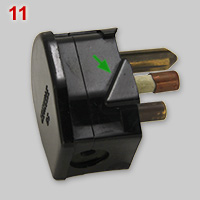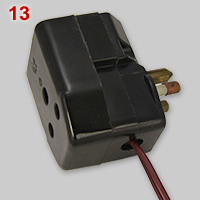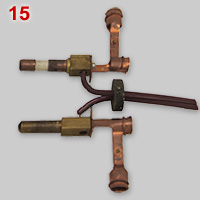 |
Dorman & Smith plugs and sockets |
BS1363 |
phased out |
|
John Raworth, electrical engineer,
started business in Manchester
around 1878. Initially he focussed on installing electric lighting on
ships as an agent for Siemens Brothers in London. In 1886 Raworth moved
to London and sold his business to two of his employees, Charles Mark
Dorman and Reginald Arthur Smith. In 1937 Thomas Atherton became
chairman and managing director of Dorman and Smith Limited. Besides
lightfittings, production and installing swithboards were and important
part of business. The company always had a reputation in producing high
quality products. The company still exists [2016] and
focuses its production on switchgear. Dorman & Smith plugs started designing plugs in 1942. Plugs were characterized by using a fuse as line pin. Relevant patents are GB566384 (appl. date: March 23, 1943) and GB574125 (appl. date: Jan. 10, 1944). Production of this type of plugs and sockets has started in 1946. From 1948 D&S sockets were installed in London County Council housing projects. Other authorities followed soon. London contracts lasted until the mid 1953 when preference was given to MK-type of fused plugs. D&S plugs and sockets gradually disappeared after the 1970s. |
  |
 |
 |
 |
 |
 |
 |
 |
 |
| 1 | Dorman & Smith socket, manufactured by Reyrolle. The Reyrolle and Company, founded by Alphonse Constant Reyrolle and based in Hebburn, Tyneside, was a large firm, specialized in development and production of switchgear and circuit breakers for power plants. After several merges it was finally acquired by Siemens. Reyrolle was licenced to produce D&S fused plugs and sockets, hence the addition of DS below the name REYROLLE. |
| 2 - 4 | D&S socket with switch. Note the D&S logo which deviates from the common (more recent ?) type; see for example plug no. 5. |
| 5 | Top view of a typical Dorman & Smith plug, see also plug nos. 9 and 10. |
| 6, 7 | D&S plugs are characterized by the unique feature of using a fuse as line pin. This design results in a more compact fused plug, compared to BS 1363 or Wylex plugs. The orientation of pins resembles 5A BS 546 plugs, but D&S pins have a larger diameter and the offset of the earth pin is 14.5 mm, rather than 20 mm for BS 546. The earth pin has a groove over its full length (see image no. 12 for details). Image no.7 shows the plug with the bottom half of its housing removed. |
| 8 | Details of the fused line pin show that
the fuse is screwed into the
pin body. The rate of the plug simply depends on the type of fuse that
is screwed in. The maximum tolerated amperage is indicate on the
copper fuse/pin cap. At least 10A and 13A fuses did exist. Fuses were
made of Alorite, an aluminium oxide ceramic. The elegance of D&S plugs was the simplicity to replace a blown fuse by simply unscrewing the pin. Other fused plugs had to be taking apart. However, the failing of the design is the risk that a fuse becomes unscrewed on its own in use, ending up protruding from the socket. Since the fuse is the line pin, great care has to be taken when removing the fuse, to avoid an electrical shock. |
 |
 |
 |
| 9 | Front view of a Dorman & Smith plug showing the externally accessible screw for wiring the earth pin. D&S plugs have the earth pin accessibility in common with BS 546 plugs. Details about this feature are given at the BS 546 page. |
| 10, 11 | D&S type plugs. No. 10 is a genuine Dorman & Smith, while no. 11 has been manufactured by Reyrolle and Company. The shape of the safety protrusion at the side of the fuse / line pin differs between the two types (see green arrows). |
 |
 |
 |
 |
 |
| 12 | D&S 2-way
multi-plug.
Earth pins of D&S plugs are are 6.6 mm longer than power pins and
have a pointed tip. Length and tip ensures that the earth pin can open
the shutters by pushing a plate aside (see also inset bottom left and
image no. 14). A groove over its full length is another characteristic of D&S earth pins. The groove is 2.8 mm wide and 1.0 mm deep. Groove and corresponding guide (see inset bottom left) ensure against attempts to open shutters with a malpositioned plug (or any other 8 mm round pin). That would result in accessible contacts because power pins are out of place. Also the size of the duroplast base plate makes it impossible to insert an incorrect oriented plug; power pins are stopped by the base plate. That is also the case for socket nos 1, 2 and 16. |
| 13 - 15 |
D&S 2-way multi-plug which also has the functionality of a so-called piggyback, given the possibility to directly connect a cord to the plug poles. Image nos. 14 shows the compents of plug no. 14. mage no. 15 illustrates cord connection to line and neutral pins. Likewise also the earth pin can be connected to the cord. |
| 16 | Exploded view of a surface mount D&S socket. The collar (left) consists of two complementary halves that are fixed by screws (of which one is shown). The benefits of a two component collar is unclear. Surface mount sockets that have a single collar also exists. |
| I am grateful to John Chittock and David Fisher for
donating D&S plugs and sockets to the museum. The History of Dorman Smith 1878-1972 by N.Lee & P.C.Stubbs, published in 1972 by Newman Neame Ltd, London gives a detailed description of the company. Many thanks to Alan Gall for sending the book. |
| Click for information about Wylex, another competitor of the BS 1363 standard |  |
|
BS1163 |
|
|
|
phased out |